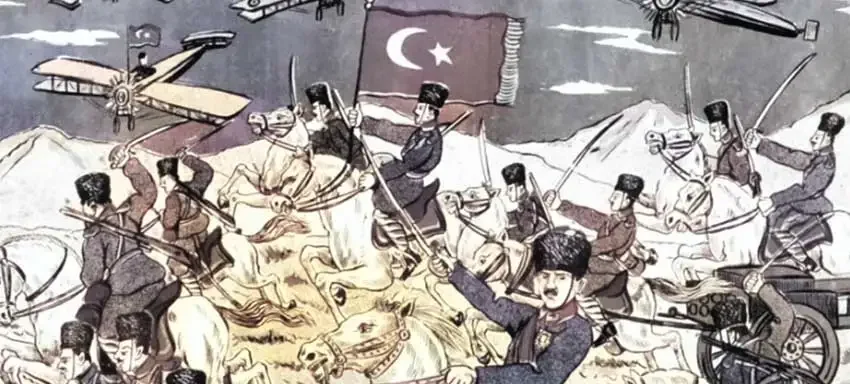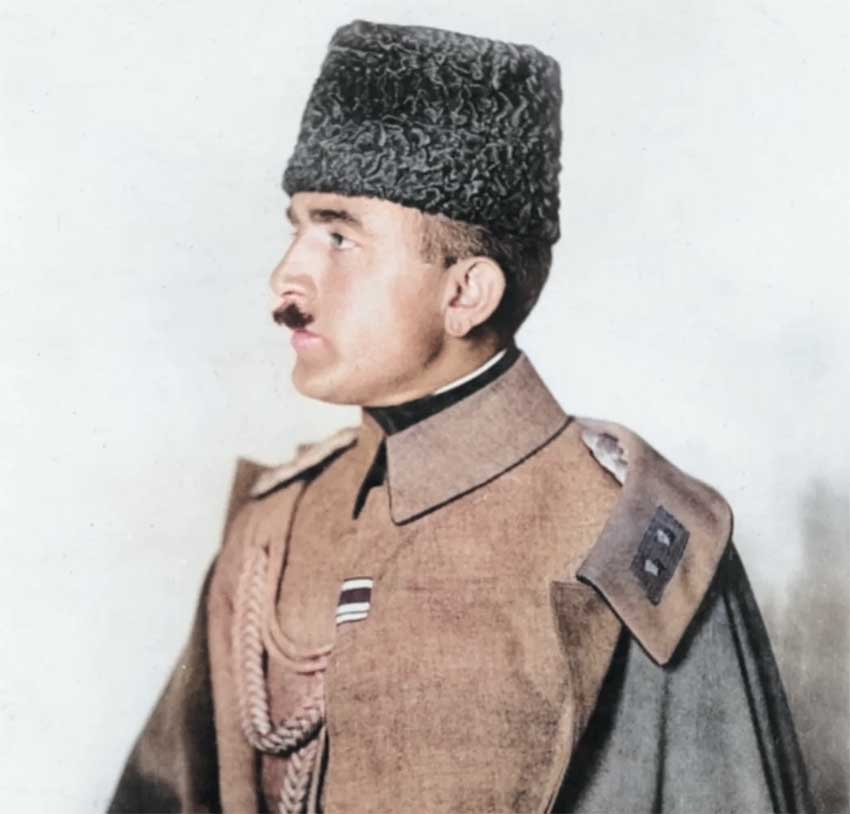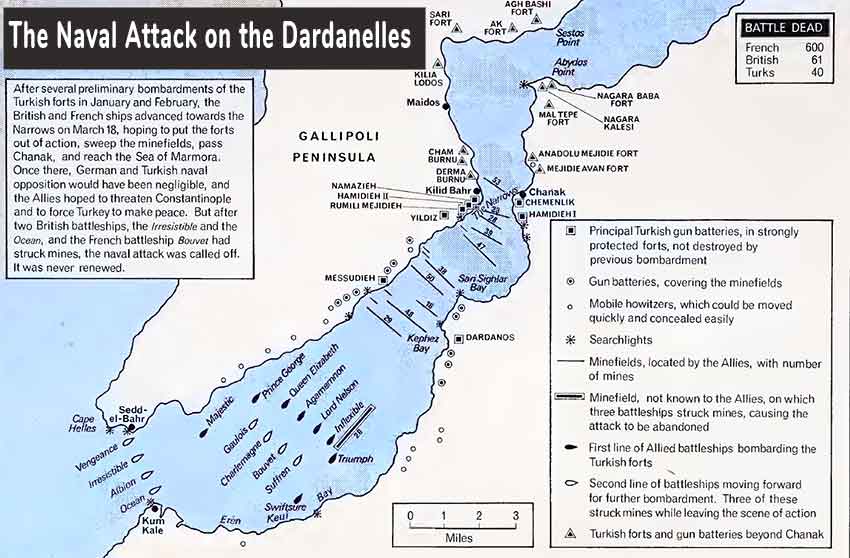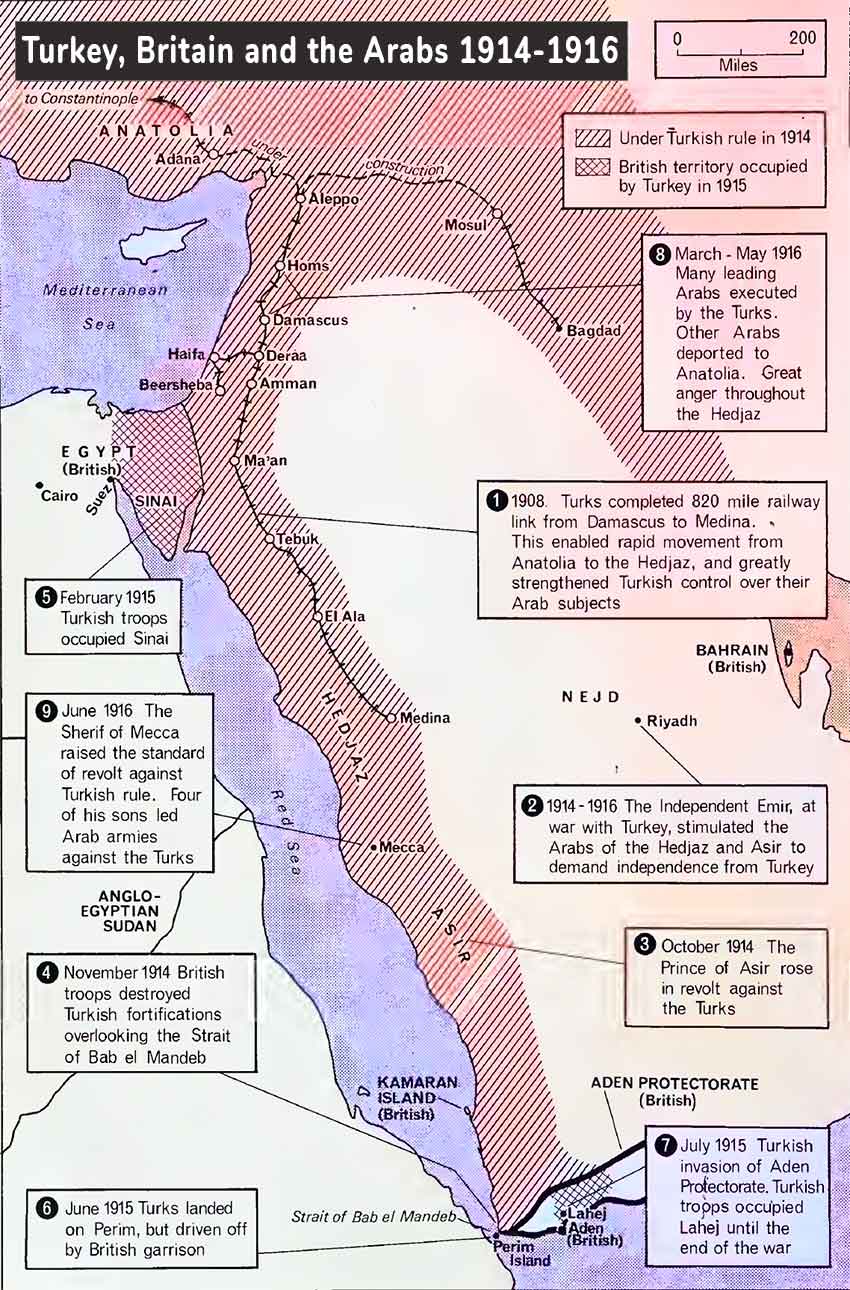- Military History
- Conflicts & Wars
- World War I
- History & Theaters WWI
- World War I - Turkish Fronts (1914–1918)

World War I - Turkish Fronts (1914–1918) Turkey a major power in World War I
Enver Pasha (1881–1922), a “Young Turk,” was one of the cadre of determined Turkish military officers who engineered the transformation of the archaic and ailing Ottoman Empire into modern Turkey.
Index of content
At the outbreak of World War I, Enver was Turkey’s minister of war, and in this capacity, without orders from any higher level, he allowed two German vessels, the Goeben and Breslau, to lead the Turkish fleet across the Black Sea to bombard the Russian ports of Odessa, Sevastopol, and Theodosia during October 29–30, 1914. The attack made up Turkey’s declaration of war and provoked Allied declarations against Turkey. Although its military was poorly equipped and poorly led, Turkey controlled the Dardanelles, the heavily fortified sea passage to and from Russia. This made Turkey a major power in World War I.
The Caucasian Campaign
Enver Pasha was eager for war as an opportunity to reap substantial territorial gains at the expense of Turkey’s perennial foe, Russia. Against the sound advice of Turkey’s ally Germany, Enver planned a campaign against Russia in the Caucasus Mountains, the natural border between Turkey and Russia. He assumed personal command of 95,000 ill-equipped and inadequately trained soldiers during November and December 1914, leading them over the forbidding Caucasian terrain.

Soon Enver found himself snowbound, whipped by severe weather, and then thoroughly outgeneraled by his Russian rivals. The Battle of Sarikamish (December 29, 1914) wiped out all but 12,000 of the would-be invaders, a loss from which the Turkish army would not fully recover during the war.
Dardanelles Campaign
By the fall of 1914, the war on the western front was stalemated. Repeatedly frustrated by the failure of attempts to break through the front, Britain’s First Lord of the Admiralty Winston Churchill (1874–1965), together with First Sea Lord Admiral John Fisher (1841–1920) and Chancellor of the Exchequer David Lloyd George (1863–1945), proposed at the beginning of 1915 an “indirect approach.” The deadlock might be broken by seizing control of the Dardanelles, opening an avenue of aid to beleaguered Russia.
This would force the Germans to transfer reinforcements from the western front to the eastern front, giving the Allies an opportunity for a breakthrough in the West. Possession of the Dardanelles would offer the West access to the vast grain fields of Ukraine, a key advantage in what had already become a war of attrition. Finally, there was the important morale factor. The defeat of Turkey would boost flagging Allied morale.
Churchill’s plan was to take the Dardanelles with an only naval operation. The scheme was attractive, but hardly workable. Although naval action might be effective against fortifications, a land operation was required to occupy whatever the navy might win. Churchill gave little thought to such a requirement.

The naval assault was launched on February 18, 1915, and encountered much greater resistance from Turkish shore batteries than had been expected. Inclement weather compounded the effect of the artillery. Worst of all, however, was the damage inflicted by Turkish mines, which had been laid in dense patterns across the Dardanelles straits.
The naval assault was broken off in March. However, in the meantime, Britain’s most senior military commander, Lord Horatio Kitchener (1850–1916), released a few divisions (including one French unit) from duty on the western front to make up a land assault force for the Dardanelles campaign. By the time the 78,000 men under the command of General Ian Hamilton (1853–1947) arrived in the straits on March 18, 1915, they were just in time to see the failure of the naval assault.
The land phase of the campaign did not begin auspiciously. Landing the troops was a confused operation, and the first soldiers did not step ashore until April 25. They were deposited on a rugged, narrow shore, thoroughly exposed to Turkish guns. Allied units, especially the ANZACs (Australia–New Zealand Army Corps), came under murderous machinegun fire. Although the Allies outnumbered the Turkish defenders six to one, their position was untenable, and they were slaughtered daily. By May 8, British mismanagement of the Dardanelles landings had created a set of entrenched beachheads. As on the western front, the deadlock now replaced the advance.
Machinegun fire and disease (the troops were exposed to the merciless sun and other elements) claimed many lives. Churchill, father of the entire operation, was disgraced, removed as First Lord of the Admiralty, then relegated to a minor cabinet post. (He soon resigned to take field command of the Sixth Royal Scots Fusiliers on the western front.)
Still, the British refused to give up. During August 6–8, 1915, a second landing was made at Suvla Bay, a few kilometers (miles) north of where the ANZACs had landed in the first assault. The fresh assault, like the first, failed, yielding only a harvest of Allied dead. On October 15, General Hamilton was relieved of command and was replaced by General Sir Charles Monro (1860–1929), who carried out a brilliant evacuation, which was concluded by January 9, 1916. It was the only aspect of the tragic Dardanelles campaign that may be said to have succeeded. Over 250,000 Allied troops had been killed or wounded, and Russia was now hopelessly cut off from its allies. As for the western front deadlock, it continued without change.
The Egypt, Palestine and Arabia Theater
Early in 1915, the British extended their defenses of the vital Suez Canal eight miles into the Sinai Desert. To do so, they had to fend off an uprising of the Sanusi (Senussi) tribes of western Egypt. In the fall of 1915, British and French officials negotiated an agreement with Hussein Ibn-Ali (1852–1931), the grand sherif of Mecca, pledging to help him gain territory and to support Arab independence from Turkey if he would cooperate with the Allies in operations against the Turks.

A British officer, T. E. Lawrence (1888–1935), worked closely with Hussein’s son Feisal (1885–1933) in a series of brilliant guerrilla actions, many of them directed against the railway line the Turks relied on for movement and supply. Lawrence’s exploits would become the stuff of legend, and “Lawrence of Arabia” would emerge as one of the few genuinely romantic figures of an otherwise unremittingly grim war.
It was not until 1917 that the British made significant headway against the Turks in the Middle East. The Battle of El Magruntein (January 8–9, 1917) forced the Turks from the Sinai Peninsula and put the British in position to take Palestine. The March 26 First Battle of Gaza went badly for the British, as did the Second Battle of Gaza (April 17–19). After the failure of the second battle, the brilliant general Edward Allenby (1861–1936) assumed overall command in the area and drove his army in a campaign to reach Jerusalem before Christmas.
The Third Battle of Gaza, also called the Battle of Beersheba, began early on the morning of October 31, 1917. Allenby attacked with great skill and determination, decimating the Turkish Seventh Army and pushing it back upon Jerusalem. The city fell to him on December 9, 1917. Having accomplished his mission, Allenby was now forced to give up many of his men to service on the western front. With his conventional forces all but idled because of a shortage of personnel, Allenby much used T. E. Lawrence as leader of Feisal’s small force of tribal warriors. These 6,000 men raided the Hejaz Railway, principal supply line for the Turks. The continual raids effectively tied down some 25,000 Turkish troops, neutralizing them as surely as if they had been defeated in battle.
In August 1917, Lawrence led a force of camel riders to disrupt Turkish rail communications and, ultimately, capture the port of Aqaba by a surprise strike from the rear. Early in the fall of 1918, the daring Lawrence approached Allenby with a plan for Arab participation in the offensive Allenby planned as the decisive campaign to end the war in the Middle East. Lawrence proposed that the Arabs form the British right flank in the army’s advance through Palestine to Damascus, Syria.

Allenby agreed, without understanding Lawrence’s underlying motive. A highly principled admirer of the Arabs, Lawrence was eager to help achieve Arab independence from the Ottoman Empire. Against Allenby’s instructions, he planned to lead the Arab contingent before Allenby and capture Damascus before the main body of British troops arrived. This would give Feisal a claim on the city as the new capital of an independent Arabia. By early September 1918, under pressure from attack by Allenby and Lawrence, the Turks evacuated Damascus, and Lawrence, at the head of 3,000 Arabs, entered the city on October 1, three hours before Allenby.
Allenby fought the culminating action of the war in the Middle East, the Battle of Megiddo, which crushed the Turkish force by September 21, 1918. A masterfully executed attack, it was without doubt the most brilliant British action of World War I. Three enemy armies were eradicated and 76,000 prisoners were taken. The cost to Allenby was light: 853 killed, 4,482 wounded, and 385 missing. From September 22 to October 30, Allenby pursued the fleeing remnants of the Turkish army.
Damascus, as mentioned above, fell on October 1, and Beirut followed on October 2. Although elements of Allenby’s infantry occupied these key cities, his Desert Mounted Corps (camel riders) led a further advance to the Syrian city of Homs (occupied October 16) and to Aleppo (occupied October 25), on Syria’s border with Turkey.
With the British on their border, the Turks agreed to an armistice on October 30, 1918. The war on the Turkish fronts was over.
Principal Combatants (Turkish front only)
Turkey vs. Russia, Britain, Australia, New Zealand, and Arab forces
Principal Theaters (Turkish front only)
Caucasus, Dardanelles, Egypt, Palestine, and Arabia
Sources and further reading
- Cyril Falls, Armageddon, 1918: The Final Palestinian Campaign of World War I (Philadelphia, University of Pennsylvania Press, 2003)
- Michael Hickey, Gallipoli (London, Murray, 1995)
- Matthew Hughes, Allenby and British Strategy in the Middle East, 1917–1919 (London and Portland, , F. Cass, 1999)
- Alan Moorehead, Gallipoli (New York, Harper Collins Perennial Classics, 2002)
- Jeremy Wilson, Lawrence of Arabia: The Authorized Biography of T. E. Lawrence (New York, Collier Books, 1992)
- {{#owner}}
- {{#url}} {{#avatarSrc}}
{{name}} {{/url}} {{^url}} {{#avatar}} {{& avatar}} {{/avatar}} {{name}} {{/url}} - {{/owner}} {{#created}}
- {{created}} {{/created}}























